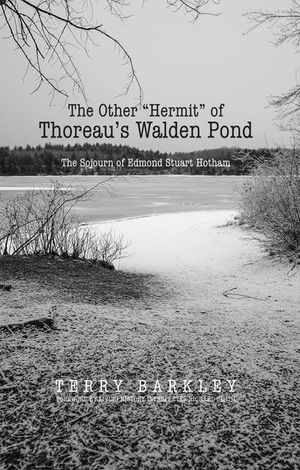The Other "Hermit" of Thoreau's Walden Pond
Published by Savas Beatie
“Barkley’s biography brings Hotham back to life and paints a picture of a complex and fascinating man.” —Richard Smith, acclaimed Living History interpreter of Henry David Thoreau
Nearly seven years after Henry Thoreau died in 1862 of tuberculosis in Concord, Massachusetts, a young theological student from New York City arrived in Concord in November 1868. Edmond Hotham had never been there, but he immediately began preparations to pursue the “wild life.” He met transcendentalist poet (William) Ellery Channing, a former close friend of Thoreau’s who had suggested to Thoreau that he build his cabin at Walden Pond. It was Channing who likely introduced Hotham to transcendentalist leader Ralph Waldo Emerson (the “Sage of Concord”), and Emerson who gave Hotham permission, like Thoreau before him, to build his “Earth-cabin” on the poet’s property at Walden Pond. Hotham built his shanty on the pond’s shore about 100 yards in front of Thoreau’s, where he attempted to out-economize and out-simplify Thoreau. Hotham’s sojourn as the second “hermit” at Walden Pond exemplified the growing adulation of Henry David Thoreau and his literary work.
Author Terry Barkley has gleaned archival sources, vital records, period newspaper accounts, and census rolls for everything that is known about Edmond Hotham. The Other “Hermit” of Thoreau’s Walden Pond is the first book-length treatise on Hotham, half of which is wholly new material. It far supersedes the late Kenneth Walter Cameron’s 1962 article on Hotham, which until now was the most complete study of the man.
Barkley’s groundbreaking study book is an important addition to the Concord-Walden Pond story and a fascinating read. To quote Thoreau, “What is once well done is done forever.”
Nearly seven years after Henry Thoreau died in 1862 of tuberculosis in Concord, Massachusetts, a young theological student from New York City arrived in Concord in November 1868. Edmond Hotham had never been there, but he immediately began preparations to pursue the “wild life.” He met transcendentalist poet (William) Ellery Channing, a former close friend of Thoreau’s who had suggested to Thoreau that he build his cabin at Walden Pond. It was Channing who likely introduced Hotham to transcendentalist leader Ralph Waldo Emerson (the “Sage of Concord”), and Emerson who gave Hotham permission, like Thoreau before him, to build his “Earth-cabin” on the poet’s property at Walden Pond. Hotham built his shanty on the pond’s shore about 100 yards in front of Thoreau’s, where he attempted to out-economize and out-simplify Thoreau. Hotham’s sojourn as the second “hermit” at Walden Pond exemplified the growing adulation of Henry David Thoreau and his literary work.
Author Terry Barkley has gleaned archival sources, vital records, period newspaper accounts, and census rolls for everything that is known about Edmond Hotham. The Other “Hermit” of Thoreau’s Walden Pond is the first book-length treatise on Hotham, half of which is wholly new material. It far supersedes the late Kenneth Walter Cameron’s 1962 article on Hotham, which until now was the most complete study of the man.
Barkley’s groundbreaking study book is an important addition to the Concord-Walden Pond story and a fascinating read. To quote Thoreau, “What is once well done is done forever.”
BUY NOW FROM
COMMUNITY REVIEWS
